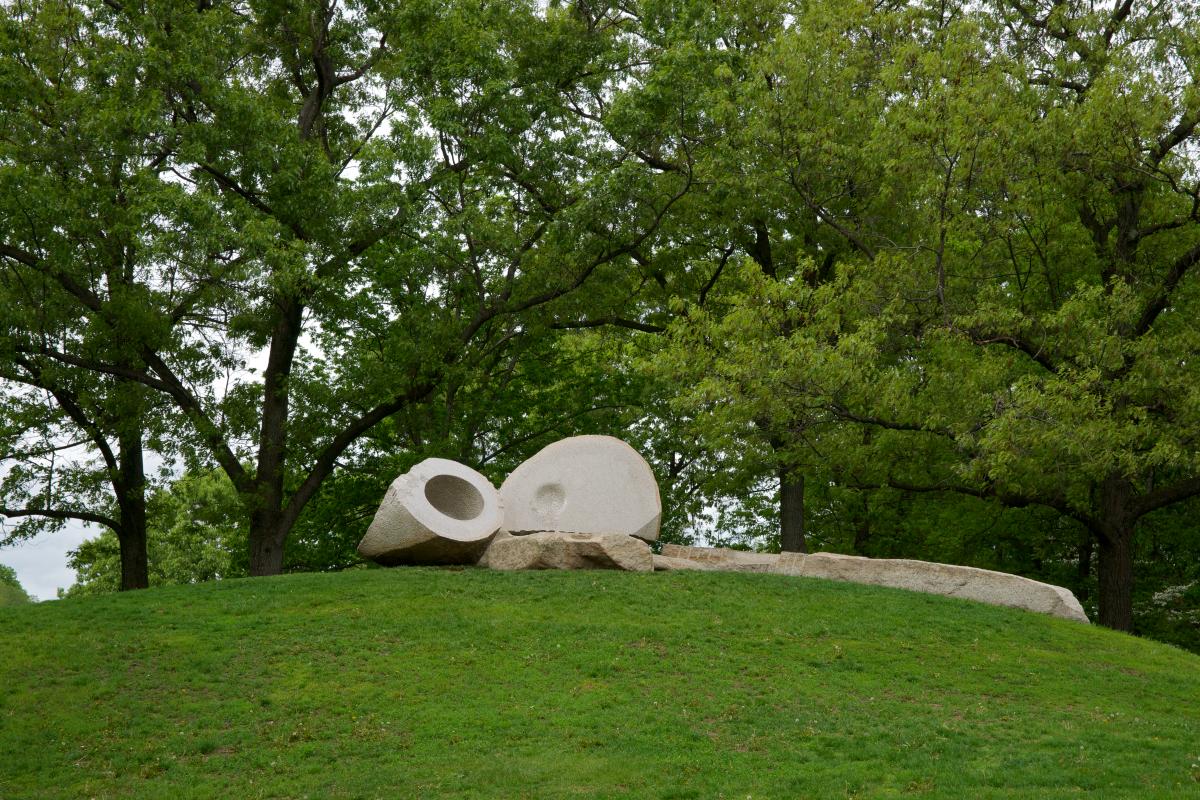On view

American, 1904–1988
Momo Taro, 1977–78
Granite
9 ft. x 34 ft. 7 in. x 21 ft. 7 in. (274.3 cm x 10.5 m x 657.9 cm)
Gift of the Ralph E. Ogden Foundation
© 2021 The Isamu Noguchi Foundation and Garden Museum, New York / Artists Rights Society (ARS), New York
Photo by Jerry L. Thompson
After Storm King’s co-founder H. Peter Stern invited Isamu Noguchi to build a sculpture for the collection, Noguchi visited in 1977, surveyed the landscape, selected a site, then returned to his studio on the Japanese island of Shikoku to work on Momo Taro. Keeping Storm King’s topography in mind, he consulted many site photographs and measurements gathered during his visit. Noguchi, admired for his unparalleled ability to blend aesthetics with function, made a model for a stone work that included two split boulders. After he began working with the stones, however, the design changed significantly. One of his assistants searched for boulders on the nearby island of Shodoshima, in the Seto Inland Sea, and found one too large to move; it had to be split. The rock’s appearance after being split reminded Noguchi’s assistants of Momo Taro, an ancient folk hero who emerged from a peach pit to become the son of an elderly couple. The work was finished within a year and installed in the spring of 1978.
The nine-part, forty-ton granite sculpture, hugging the earth and anchored to a concrete base underground, sits atop a specially landscaped hill with commanding views of the surrounding area. The dramatic setting on a high mound was created at the artist’s request by former Storm King landscape architect William A. Rutherford, Sr. The hill is integral to the work. As Noguchi noted, “The sculpture lives as part of a hill. It was the hill that got me going, which inspired me.” While Noguchi is known for creating fully orchestrated environments, on this occasion he set his carved stones into surroundings whose ultimate evolution would be out of his control.
The full realization of Momo Taro depends on the interaction of visitors, who are invited not only to touch but also to enter, sit on, and rest their bodies on the work—to participate in its existence. Noguchi’s flat bench provides a welcome site for contemplation. The central element of the piece—the hollowed-out granite “peach pit”—serves as a cool, peaceful retreat, even on the hottest summer day. Noguchi expressed his wish that visitors, especially children, would sing and make noise inside the cavity, enjoying its special aural resonance. The “mirror,” a highly polished surface, is angled to fully reflect the sun in summer. The theatrical aspect of the work as a place for action or social gathering reflects Noguchi’s extensive history of designing stage sets, primarily for the pioneering choreographer Martha Graham between 1935 and 1966, as well as public plazas and playgrounds.
The nine-part, forty-ton granite sculpture, hugging the earth and anchored to a concrete base underground, sits atop a specially landscaped hill with commanding views of the surrounding area. The dramatic setting on a high mound was created at the artist’s request by former Storm King landscape architect William A. Rutherford, Sr. The hill is integral to the work. As Noguchi noted, “The sculpture lives as part of a hill. It was the hill that got me going, which inspired me.” While Noguchi is known for creating fully orchestrated environments, on this occasion he set his carved stones into surroundings whose ultimate evolution would be out of his control.
The full realization of Momo Taro depends on the interaction of visitors, who are invited not only to touch but also to enter, sit on, and rest their bodies on the work—to participate in its existence. Noguchi’s flat bench provides a welcome site for contemplation. The central element of the piece—the hollowed-out granite “peach pit”—serves as a cool, peaceful retreat, even on the hottest summer day. Noguchi expressed his wish that visitors, especially children, would sing and make noise inside the cavity, enjoying its special aural resonance. The “mirror,” a highly polished surface, is angled to fully reflect the sun in summer. The theatrical aspect of the work as a place for action or social gathering reflects Noguchi’s extensive history of designing stage sets, primarily for the pioneering choreographer Martha Graham between 1935 and 1966, as well as public plazas and playgrounds.
